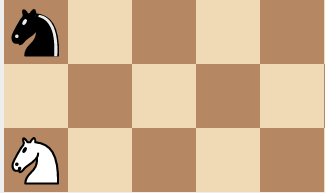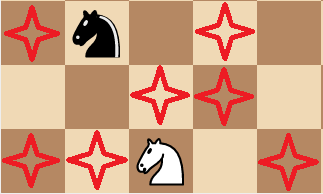Annoying Knights
Dan and Sam play a game on a board. Dan places a White Knight on a corner and Sam places a Black Knight on the nearest corner. Each one moves his Knight in his turn to squares that have not been already visited by any of the Knights at any moment of the match.
For example, Dan moves, then Sam, and Dan wants to go to Black Knight's initial square, but he can't, because this square has been occupied earlier.

When someone can't move, he loses. If Dan begins, who will win, assuming both players play optimally?
This is the seventeenth problem of the set Winning Strategies .
This section requires Javascript.
You are seeing this because something didn't load right. We suggest you, (a) try
refreshing the page, (b) enabling javascript if it is disabled on your browser and,
finally, (c)
loading the
non-javascript version of this page
. We're sorry about the hassle.
Relevant wiki: Combinatorial Games - Winning Positions
I will show what Dan has to do in order to win (does not matter what Sam plays):
After the first turn the position is this one
Sam was forced to play his knight to that position because there are not possible remaining squares in which he can place his knight on. I've marked the squares already visited with a red star.
Dan must move his knight to the bottom right corner. Now Sam's options are two squares; I will show each variant:
This one is really simple, because, after this turn, each Sam's move is forced
Each Dan's move must be done in order to enclose Sam's Knight.
After Sam's move, Dan just need to move his knight to the only square where Sam could have placed his knight, and Dan wins
The second variant is a little bit longer, but after some turns, Sam loses
Sam now has 3 squares to place his knight on; two of them are equivalent
And Dan just need to move his knight to the Black knight's remaining square. Thus, Dan wins.
If Sam plays
The result is the same as in previous option.
Finally, Sam can play
And so Dan simply plays
In the next turn, Sam can't move. Sam could have moved to another square, but then the result is the same.
Therefore, Dan wins.